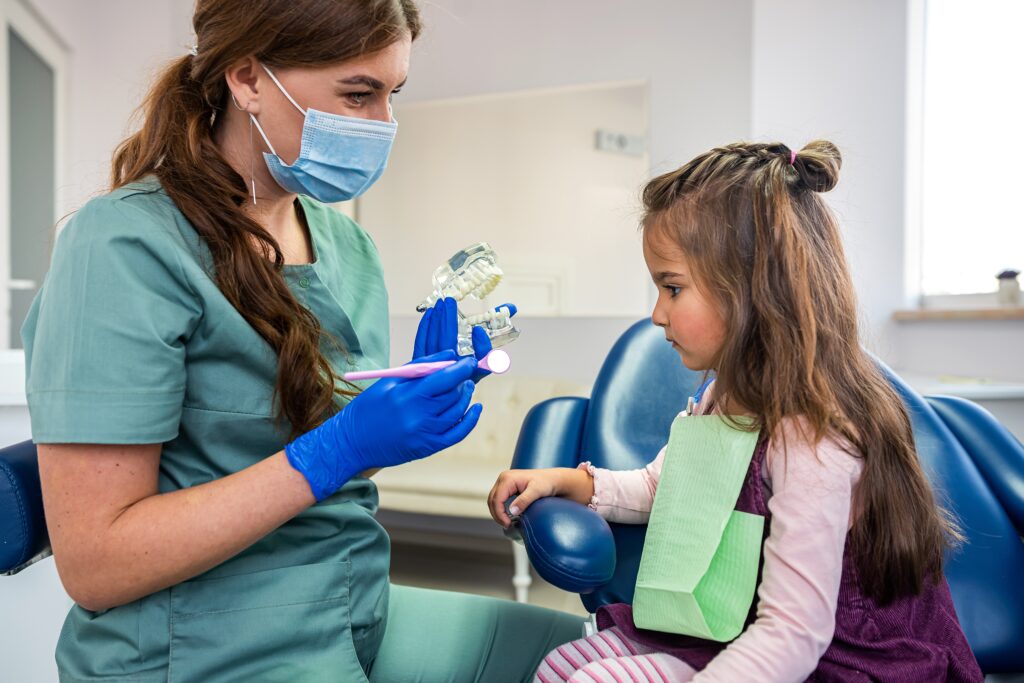There are opportunities to do more to improve the dental health of Australian children, a move that will deliver immediate and long term benefits, as well as diminish the burden of disease.
Tooth decay is the most common preventable chronic childhood condition in Australia.
Tooth decay affects up to 60–90% of school-aged children in most high income countries (here and here) and around one in three Australian children by the time they start school. Worryingly, this figure is trending upwards (here and here). Tooth decay is also a leading cause of preventable hospital admissions for Australian children.
The burden of tooth decay is not equally shared. There are differences related to where children live, their families and their environments. Children from families experiencing adversity are most likely to have tooth decay. At age eight to nine years, 33% of Australian children from families experiencing the greatest adversity had tooth decay, compared with 24% of children from families not experiencing adversity. Both numbers are high. This makes tooth decay one of the areas of greatest preventable health inequity in Australia.
All children in Australia should be able to have good dental health. Poor dental health in childhood can impair children’s ability to eat, sleep and socialise, which may then affect health and wellbeing into adulthood. Tooth decay also shares common risk factors with other chronic diseases. From the research we know factors associated with an increased risk of tooth decay include consumption of sugar, poor dental hygiene, lack of access to fluoridated water, and inadequate access to and availability of dental services.

A recent article using existing data from four high income areas – Australia, Québec (Canada), Rotterdam (the Netherlands), and south-east Sweden – showed variation in the prevalence and distribution of inequalities in children’s dental health across jurisdictions, indicating they may be responsive to differences in policies across countries. These findings highlighted that reducing inequities in childhood tooth decay requires combining or “stacking” complementary prevention strategies targeting risk factors. This is particularly important for children from families experiencing adversity.
Given the research, three key policy opportunities likely to deliver immediate and enduring improvements in reducing inequities in child dental health in Australia are universal access to dental services, use of fluoride, and reducing exposure to sugar.
Access to dental services
The World Health Organization global strategy for oral health recommends major reforms to provide inclusive, accessible and affordable dental health care. This includes the need to close financing gaps to align goals of universal primary health care coverage, and to establish data-driven evidence-informed policy for dental health care. Although their recommendations primarily focus on low and middle-income countries, it is also timely and necessary to advance policy action in high income countries such as Australia, given the extent of inequalities.
In Australia, Medicare provides inconsistent dental health coverage. In 2020–2021, individuals spent 19.6% of their health expenditure on dental services. The cost of private dental care is unaffordable for some families and there are long wait times to access public dental services. In 2014, the Child Dental Benefits Schedule (CDBS) was introduced, which provides children from low and middle-income families with a capped benefit for basic dental services. However, only 38% of eligible children accessed the program in 2018, indicating that cost is only one of the many barriers for these children.
Four priority population groups were identified in Australia’s National Oral Health Plan 2015–2024 as experiencing service gaps resulting in an unmet need for dental services: those experiencing socio-economic disadvantage, Aboriginal and Torres Strait Islander Australians, those living in regional and remote areas, and those with additional and/or specialised health care needs. However, the latest Australian Institute of Health and Welfare update monitoring Australia’s progress towards implementing this plan is mixed, with multiple key performance indicators showing either no change or unfavourable trends.
A recent Greens-led Senate inquiry recommended expanding the scope of public subsidies under Medicare, using the CDBS as a model, and prioritising accessibility for these population groups. There is an opportunity for policy action to consider how best to service these populations, initially by addressing barriers to the existing Medicare offerings to ensure adequate distribution and equitable uptake of services.
Indeed, international research points to the importance of providing universal health coverage for dental services (including preventive care) for all children and their families to address inequities. Preventive care needs a family-level approach. Parents have a critical role in helping children to establish and maintain good dental habits. Providing all members of the family with free access to preventive care is a critical factor in addressing inequities.
In Australia, there is evidence of the inverse care law operating dental services; that is, those that most need a service are least likely to get it. Barriers for families experiencing adversity can include cost, workforce availability, wait times, and health literacy. Research has shown that children from families experiencing the greatest adversity were the least likely to access dental services, both for prevention and intervention. Only 24% of children experiencing the greatest adversity (according to parents’ income, education and occupation) reported use of dental services for prevention in the absence of tooth decay, compared with 50% of children not experiencing adversity. Children experiencing the greatest adversity were also more likely to report they had not used dental services even when they had experienced tooth decay, indicating an unmet need for care.
Ensuring universal prevention-focused dental care in the early years will require the active involvement of health professionals other than dentists, such as general practitioners, paediatricians and child and family health services. Given their frequent contact with children in the early years, these health professionals are well placed to provide education and early referral.
Use of fluoride
Continued promotion of fluoride is an important public health prevention target. The use of fluoride is a policy sensitive lever that is highly effective for reducing childhood tooth decay and lessening the social gradient.
Those living in regional and remote areas were identified as a priority population group, and yet access to fluoridated water is variable across rural and remote Australia. Australian research has shown that the likelihood of having tooth decay was highest for children from families experiencing adversity who lived in areas with a non-fluoridated water supply, and lower for those in metropolitan areas with a fluoridated water supply; in other words, access to fluoridated water lessened the social gradient. A recent study of rural Victorian towns suggests more consistent access to fluoridated drinking water across regional and remote Australia can help reduce childhood tooth decay.
Exposure to sugar
Decreasing children’s exposure to sugary food and drinks would have a significant impact on their dental health. Children who consume more sugary food and drinks are more likely to get tooth decay. Food marketing aimed at children is highly prevalent, predominantly advertising sugar-sweetened food and drinks. This exposure to food marketing is also a widely recognised risk factor for obesity in childhood. Continued health promotion to restrict children’s exposure to sugary food and drinks may include supporting tighter rules around junk food advertising, clearer labelling of products, and introducing a tax on sugary beverages. A global umbrella review found a tax on sugar-sweetened beverages could reduce childhood tooth decay by 2.9% in high income countries.
Experiencing adversity may also lead to eating a poor quality diet, due in part to the higher cost of fresh foods compared with the relative affordability of processed foods, which often include higher amounts of sugar. Greater policy efforts are needed to facilitate access to affordable healthy foods and positive changes in children’s diets that will promote good dental health and reduce inequities.
Conclusion
There are immediate and doable actions that could reduce tooth decay in Australian children and address the inequalities in child dental health. These inequalities will be exacerbated by the current cost of living crisis, potentially exposing more children to the risk of tooth decay. We have the measures to prevent this from happening and ensure we do not create a new generation of children with tooth decay.
Improving dental health in childhood would deliver immediate and long term individual and collective benefits, as well as diminish the burden of disease. It is time we remember the importance of children’s teeth and act now.
Professor Sharon Goldfeld is a paediatrician, Director of the Centre for Community Child Health at the Royal Children’s Hospital, and Director of Population Health at the Murdoch Children’s Research Institute in Melbourne.
Elodie O’Connor is a Research Officer at the Murdoch Children’s Research Institute and Honorary Fellow at the Department of Paediatrics, University of Melbourne.
Kate Francis is a Senior Research Officer at the Murdoch Children’s Research Institute.
Fiona Mensah is a Senior Research Fellow at the Murdoch Children’s Research Institute.
Dr Mihiri Silva is a consultant paediatric dentist at the Royal Children’s Hospital, a Clinician-Scientist Fellow at the Murdoch Children’s Research Institute, and a Senior Lecturer in Paediatric Dentistry at the Melbourne Dental School, University of Melbourne.
The statements or opinions expressed in this article reflect the views of the authors and do not necessarily represent the official policy of the AMA, the MJA or InSight+ unless so stated.
Subscribe to the free InSight+ weekly newsletter here. It is available to all readers, not just registered medical practitioners.
If you would like to submit an article for consideration, send a Word version to mjainsight-editor@ampco.com.au.

 more_vert
more_vert
I wonder what quantum of funding would make change in a state like NSW. Would $5million put a dent into lifting the availability of public dental services (for children and adults) for example? Or might it be 10x that?